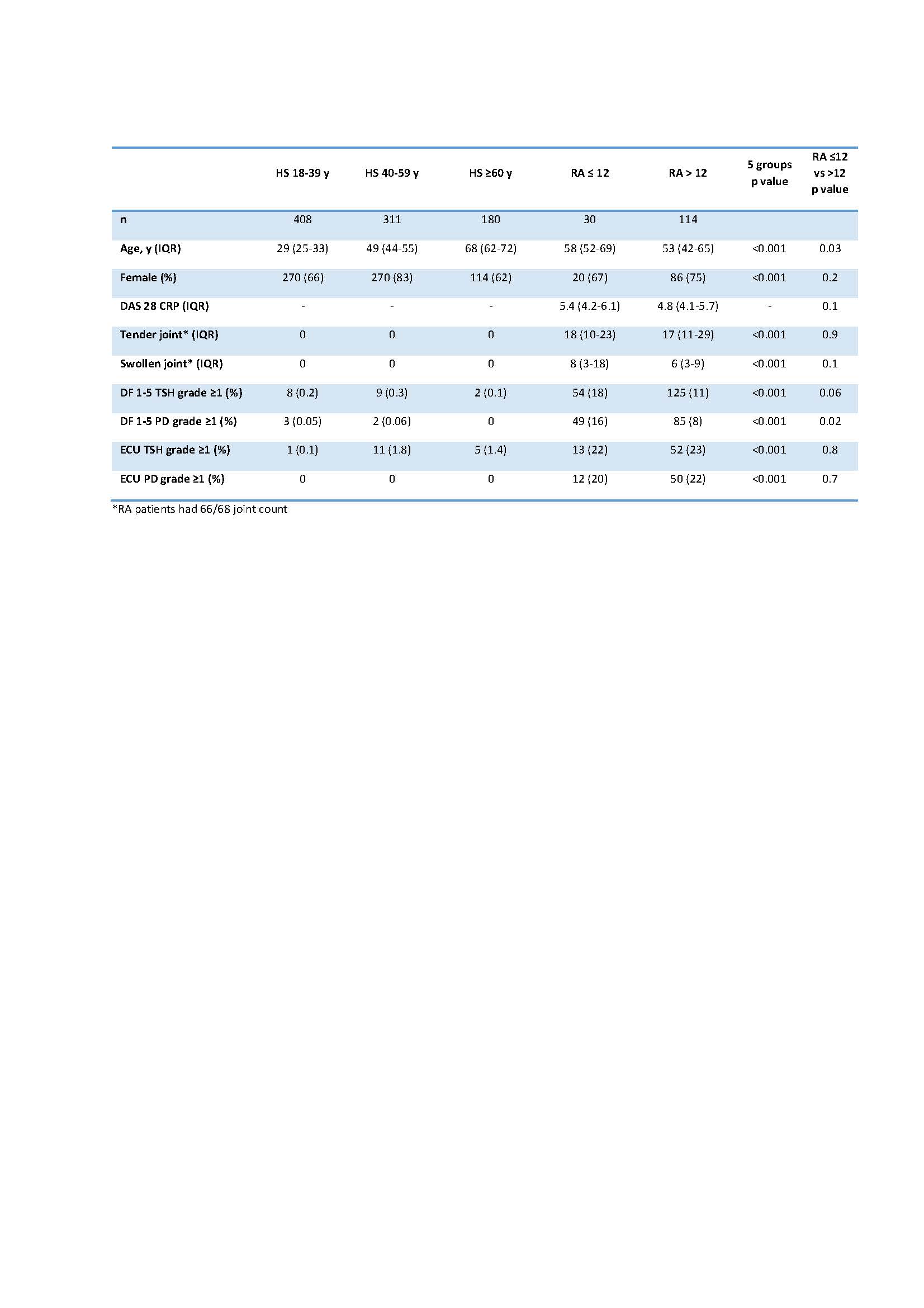Session Information
Session Type: ACR Abstract Session
Session Time: 2:30PM-4:00PM
Background/Purpose: Tenosynovitis (TS) is a common, often clinically undetectable finding in Rheumatoid Arthritis (RA). Recent data showed TS on ultrasound (US) has a role in predicting outcome in early disease and flare in clinical remission. However data is limited on US measured TS in healthy subjects (HS), none specifically encompassing the older age range when RA commonly presents. This OMERACT study aimed to determine prevalence of US measured tendon abnormalities in HS throughout the age range.
Methods: Adult healthy subjects without: joint pain (VAS < 10/100), hand osteoarthritis (ACR criteria), or inflammatory arthritis were recruited in 23 international centres from Aug 2017-Dec 2018. MCP, PIP and wrist joints were clinically examined. Bilateral digit flexor (DF) 1-5 and extensor carpi ulnaris (ECU) tendons were scanned for tenosynovial hypertrophy (TSH) and power Doppler (PD) signal and graded (OMERACT US scoring system). A comparison cohort of DMARD-naive patients with RA (ACR-EULAR 2010 and/or 1987 criteria) at presentation was taken from the Birmingham Early Arthritis (BEACON) inception cohort, who underwent identical tendon US assessment. They were grouped into ≤12 and > 12 weeks from symptom onset. Abnormal ultrasound findings were dichotomised in to grade 0 (absent) or grade 1-3 (present) for statistical analysis (Fisher’s exact test).
Results: Data from 899 HS and 144 RA patients were included. Prevalence of TSH and particularly PD abnormalities in HS was very low in all age groups, and was all grade 1 except in one individual ECU tendon. ECU TSH grade≥1 was more common than DF grade≥1 in the older HS groups, and less common in the 18-39 age group (p=0.011). TSH and PD of grade ≥1 were common in RA patients (p ≤0.001), with DF PD abnormalities more common in early disease (p=0.02).
Conclusion: Very low prevalence of TSH or PD abnormalities in tendons of healthy subjects even in old age suggests ultrasound determined tenosynovitis will be a robust tool in clinical management of RA.
To cite this abstract in AMA style:
Trickey J, Sahbudin I, Bortoluzzi A, IAGNOCCO A, Pineda C, Sifuentes-Cantú C, Ciurtin C, Reátegui-Sokolova C, Fodor D, NAREDO E, Hauge E, Vreju F, Sakellariou G, Bruyn G, Filippou G, La Paglia G, Leon G, Gouze H, Keen H, Hammer H, Tinazzi I, Azzolin I, Fliciński J, Ikeda K, Terslev L, Danielsen M, Rasch M, Milchert M, Stoenoiu M, Kortekaas M, Gutierrez M, Maruseac M, Mortada M, Carron P, Karalilova R, Wittoek R, Ohrndorf S, Suzuki T, Șerban T, D’Agostino M, Filer A. Very Low Prevalence of Ultrasound Determined Tendon Abnormalities in Healthy Subjects Throughout the Age Range: An Outcome Measures in Rheumatology (OMERACT) Ultrasound Minimal Disease Study [abstract]. Arthritis Rheumatol. 2019; 71 (suppl 10). https://acrabstracts.org/abstract/very-low-prevalence-of-ultrasound-determined-tendon-abnormalities-in-healthy-subjects-throughout-the-age-range-an-outcome-measures-in-rheumatology-omeract-ultrasound-minimal-disease-study/. Accessed .« Back to 2019 ACR/ARP Annual Meeting
ACR Meeting Abstracts - https://acrabstracts.org/abstract/very-low-prevalence-of-ultrasound-determined-tendon-abnormalities-in-healthy-subjects-throughout-the-age-range-an-outcome-measures-in-rheumatology-omeract-ultrasound-minimal-disease-study/


